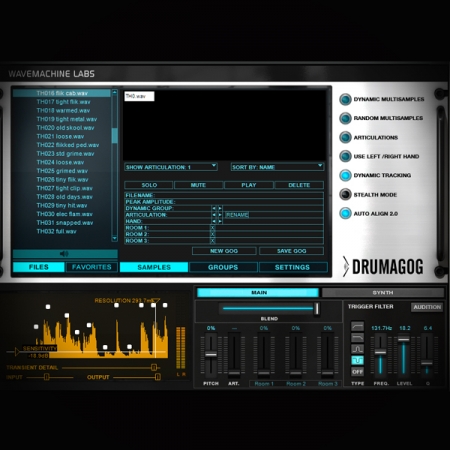Extracting Drum Sounds from a Beat using Drumagog
How to rip and replace drum sounds (drum elements) within a beat using Drumagog.
Beat Construction
Purchase to view this tutorial
By purchasing this tutorial, you'll get immediate access - your purchase helps create new and exciting content and this site survive!
$4.15Add to basket
Extracting Drum Sounds from a Beat using Drumagog video tutorial explains how to use Drumagog to replace drum sounds in an existing drum beat.
Today’s producers need to combine production techniques with sound design principles if they want to create their own signature sounds and colour. It is this single distinction that separates one producer’s signature sound from another. I am sure you can instantly recognise a beat from Dr Dre the minute you hear it. This is what we refer to as a signature sound or colour.
If you are like me, a poor drummer, then you will appreciate how hard it is to create your own drum beats that carry your specific style. It’s not just about getting the right timing in place for the beat, it’s about selecting the right combination of sounds that add to the beat and make it stand out above the competition. I, sadly, am poor at getting a really good groove together but am quite proficient at marrying sounds together to form a solid and interesting drum kit to be used in beat productions. The ability to take a commercial drum break and remove the individual drum sounds from it and replace it with your own custom sounds is a huge step forward for people like me who are not proficient at laying down a groove. I can use the existing commercial groove but with my own sounds.
The process entails using drum replacement software to trigger the new drum sounds based on where the existing drum sounds lie within the drum beat. Drum replacement software look for peak transients that define the start of a drum sound and use these peaks as triggers to trigger new drum sounds. In effect, these peak transients are used as midi notes on data. It is a simple process but highly effective. The drum replacement software affords all manner of tools to help refine this process from filtering to isolate specific sounds to adjustable peak transient detectors which help in locating instances of multiple peak transients. Once the peak transients have been located the drum replacement software can replace each transient with a specified sound.
In the Extracting Drum Sounds from a Beat using Drumagog video, I use WaveMachine Labs Drumagog to locate and replace all the drum sounds within a commercial drum break – Ice Box by Timbaland. I use three instances of Drumagog to separate different drum sounds from the existing commercial break. I then substitute the drum sounds with my own custom sounds and layer all three Drumagog instances to create a new drum beat. I explain how Drumagog works and how best to use it to isolate the drum sounds. I explain how to isolate the kick drum, the snare drum and the hi-hats using the filtering tools in Drumagog. I show you how to use the transient detection tool to locate peak transients and I make sure to explain how to avoid the usual retriggering problems associated with transient detection processes. I end by using an equaliser to further shape the drum sounds so they fit into the drum beat.
Plugins used in this video:
Topics covered in this video are:
- How to Rip Beats successfully
- Drum Elements and Layering
- ADSR and Envelopes
- Understanding Timing and Sync
- Using Drum Replacement Software
- Understanding Sensitivity and Threshold
- Replacing Drums Within a Beat
- Aligning and Timeline Prep
- Tips and Tricks
If this tutorial was of help maybe these will also be of benefit:
Programming Drum Beats in Cubase
The Art of Drum Layering (second edition)
The Art of Drum Layering – Advanced
Ripping and using Timing Information from a Drum Beat
Chopping/Slicing Beats Using Recycle
Using Recycle REX Files and Constructing New Beats
Combining Ripped Beats to create new Beats
Processing a Snare to fit in with a Ripped Drum Break
Extracting Audio Slices from any Beat and Converting them to Midi
Topping and Tailing Ripped Beats – Truncating and Normalising

